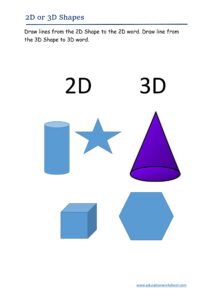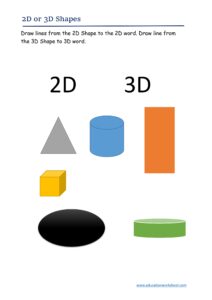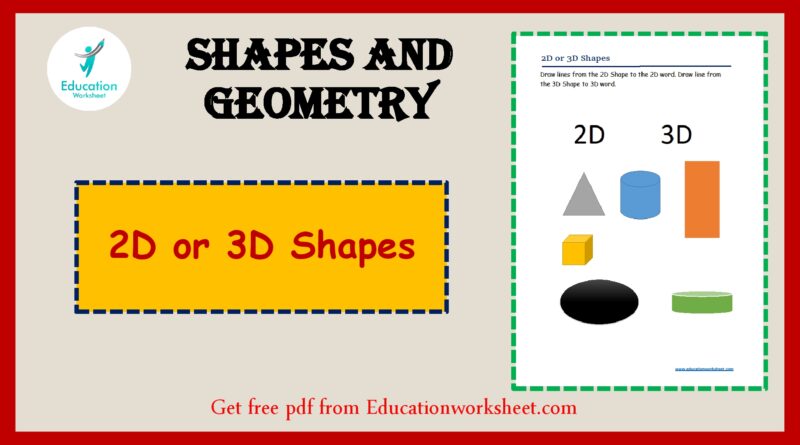Identify 2D and 3D shapes
-
Identify 2D and 3D shapes
- . Understanding 2D Shapes: 2D shapes are flat and have only two dimensions: length and width. They are typically represented on a flat surface, like a piece of paper or a computer screen. Here are some common 2D shapes and their characteristics:
- Circle: A 2D shape with a round, curved boundary. It has no corners or angles. The distance across the circle through its center is called the diameter.
- Square: A 2D shape with four equal sides and four right angles (90-degree angles). Opposite sides are parallel, and all angles are equal.
- Rectangle: A 2D shape with four right angles (90-degree angles). Opposite sides are parallel, but unlike a square, it has unequal side lengths.
- Triangle: A 2D shape with three sides and three angles. Triangles can have different types of angles, such as equilateral (all angles are equal), isosceles (two sides are equal), or scalene (no sides are equal).
- Polygon: A 2D shape with multiple straight sides. Common polygons include pentagons (5 sides), hexagons (6 sides), and octagons (8 sides).
2. Identifying 3D Shapes:
- 3D shapes, also known as solid shapes, have three dimensions: length, width, and height (or depth). They occupy space and are not flat like 2D shapes. Here are some common 3D shapes and their characteristics:
- Cube: A 3D shape with six equal square faces, 12 edges, and eight vertices (corners).
- Sphere: A 3D shape resembling a ball or a globe. It has no edges or vertices. The distance from its center to any point on its surface is called the radius.
- Cylinder: A 3D shape with two circular faces and a curved surface connecting them. It has three parts: two circular bases and one lateral (side) surface.
- Cone: A 3D shape with a circular base that narrows to a single point called the apex. It has one curved surface and one circular base.
- Pyramid: A 3D shape with a polygonal base (like a square or triangle) and triangular faces that meet at a single vertex (apex). The number of sides on the base determines the name of the pyramid (e.g., a square pyramid has a square base).

Identify 2D and 3D shapes
3. Differentiating Between 2D and 3D Shapes:
- Number of Dimensions: The primary distinction is that 2D shapes exist in two dimensions (length and width), while 3D shapes exist in three dimensions (length, width, and height).
- Flat vs. Solid: 2D shapes are flat and do not occupy space, whereas 3D shapes are solid and have volume.
- Edges and Vertices: 2D shapes have edges (lines) and vertices (corners), but they are not as prominent as in 3D shapes, which have well-defined edges, faces, and vertices.
- Visual Appearance: 2D shapes are usually drawn on a flat surface and appear as flat figures, while 3D shapes have depth and appear as solid objects.
Understanding the differences between 2D and 3D shapes is fundamental in mathematics, geometry, and real-life applications, as it allows you to classify and work with a wide range of shapes and objects accurately.
3D Shapes (Three-Dimensional):
- Depth and Volume: 3D shapes have depth, volume, and three dimensions – length, width, and height. They are not flat like 2D shapes.
- Examples: Common 3D shapes include:
- Cube: A six-sided shape with all sides and angles equal. It’s like a 3D version of a square.
- Sphere: A round, ball-like shape with a curved surface.
- Cylinder: A shape with two flat, circular ends and a curved surface connecting them.
- Cone: A shape with a circular base that narrows to a point at the top.
- Pyramid: A multi-sided shape with a polygonal base and triangular faces that meet at a single vertex.

Identify 2D and 3D shapes
Key Differences:
- Dimensions: 2D shapes have two dimensions (length and width), while 3D shapes have three dimensions (length, width, and height).
- Flat vs. Solid: 2D shapes are flat and have no thickness, while 3D shapes are solid and occupy space.
- Examples: 2D shapes include circles, squares, and triangles, while 3D shapes include cubes, spheres, and cylinders.
- Applications: 2D shapes are commonly used in art, design, and graphics, while 3D shapes are essential in architecture, engineering, and three-dimensional modeling.
By recognizing these key distinctions and practicing with various shapes, you’ll become adept at identifying 2D and 3D shapes in both everyday objects and geometric diagrams.

